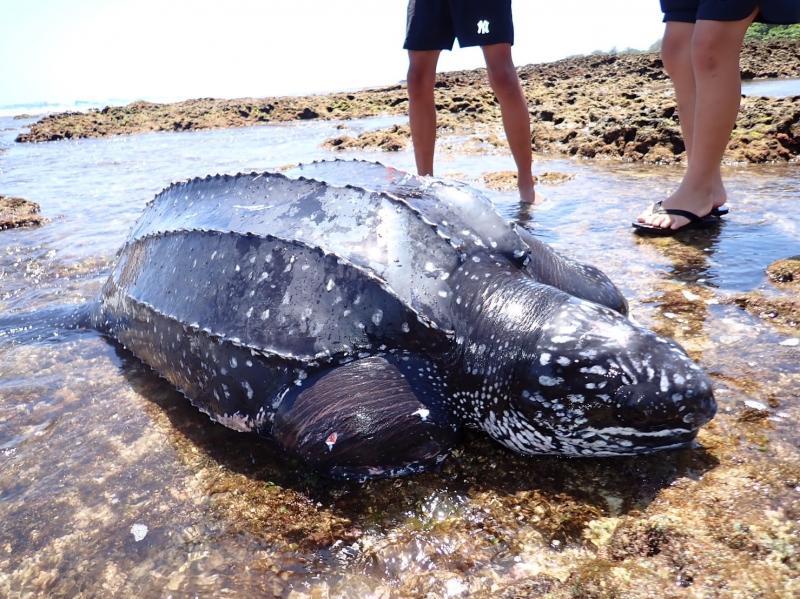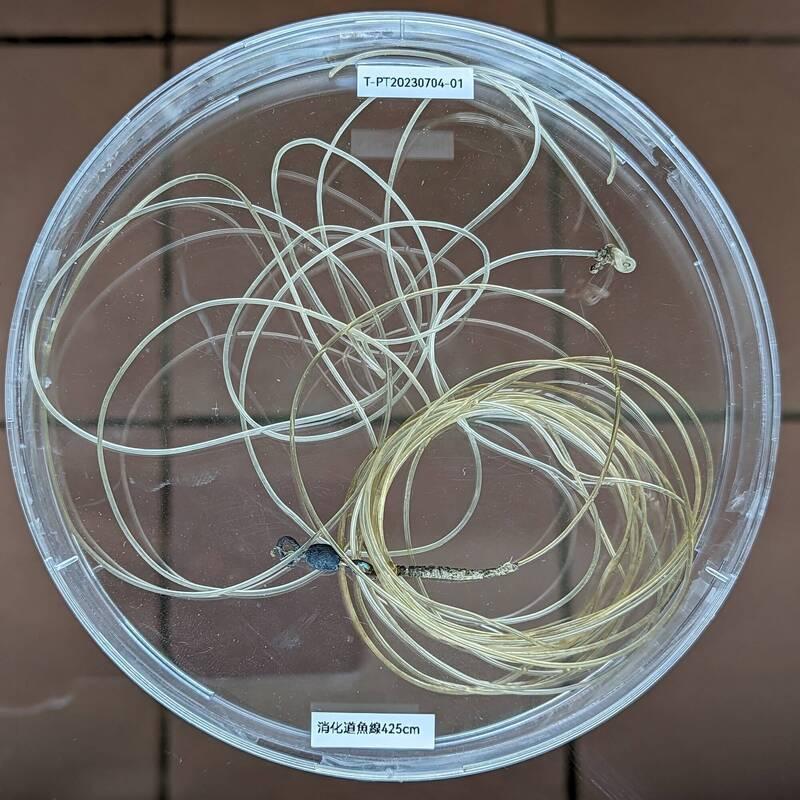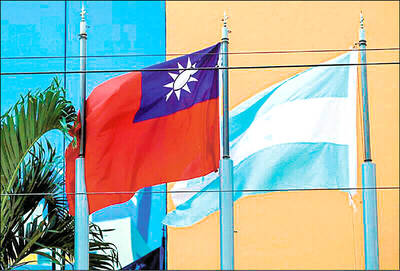A leatherback turtle that was discovered near death in Kenting National Park in July was killed by swallowed fishing lines, the Ocean Conservation Administration (OCA) said on Wednesday.
The 130kg adolescent turtle, of a species that is rarely seen near Taiwan, was discovered on July 4 washed onto a beach at Wanlitong (萬里桐) in Pingtung County’s Hengchun Township (恆春).
It was transferred to a rescue center for treatment, but died a day later.

Photo courtesy of a resident surnamed Hung
An autopsy discovered no food in its stomach and an abnormally twisted digestive tract, the OCA said.
An X-ray then revealed two fishing lines totaling 425cm in length that had apparently been there for some time, extending from the stomach to the large intestine, it said.
The line embedded into the intestinal lining, resulting in irritation and bleeding, and making it impossible for the turtle to digest food, it said.

Photo courtesy of the Ocean Conservation Administration
Lesions in the digestive tract eventually led to necrotizing enterocolitis and acute sepsis, the agency added.
Since discarded fishing lines often attach to other sea life, they are easily ingested by turtles, causing grievous harm, the OCA said.
Even after a turtle dies and decomposes, the fishing line could then go on to harm other sea creatures, it said, calling on fishers not to dispose of fishing lines in the ocean.

The Ministry of Economic Affairs has fined Taobao NT$1.2 million (US$36,900) for advertisements that exceeded its approved business scope and ordered the Chinese e-commerce platform to make corrections in the first half of this year or its license would be revoked. Lawmakers have called for stricter supervision of Chinese e-commerce platforms and more stringent measures to prevent China from laundering its goods through Taiwan as US President Donald Trump’s administration cracks down on origin laundering. The legislature’s Finance Committee yesterday met to discuss policies to prevent China from dumping goods in Taiwan, inviting government agencies to report on the matter. Democratic Progressive Party

Taiwan and its Pacific ally Tuvalu on Tuesday signed two accords aimed at facilitating bilateral cooperation on labor affairs, according to Taiwan’s Ministry of Foreign Affairs (MOFA). The governments inked two agreements in Taipei, witnessed by Foreign Minister Lin Chia-lung (林佳龍) and visiting Deputy Tuvaluan Prime Minister Panapasi Nelesone, MOFA said in a news release. According to MOFA, the agreements will facilitate cooperation on labor issues and allow the two sides to mutually recognize seafarers’ certificates and related training. Taiwan would also continue to collaborate with Tuvalu across various fields to promote economic prosperity as well as the well-being of their

Taiwan would welcome the return of Honduras as a diplomatic ally if its next president decides to make such a move, Minister of Foreign Affairs Lin Chia-lung (林佳龍) said yesterday. “Of course, we would welcome Honduras if they want to restore diplomatic ties with Taiwan after their elections,” Lin said at a meeting of the legislature’s Foreign Affairs and National Defense Committee, when asked to comment on statements made by two of the three Honduran presidential candidates during the presidential campaign in the Central American country. Taiwan is paying close attention to the region as a whole in the wake of a

NEW WORLD: Taiwan is pursuing innovative approaches to international relations through economics, trade and values-based diplomacy, the foreign minister said Taiwan would implement a “three-chain strategy” that promotes democratic values in response to US tariffs, Minister of Foreign Affairs Lin Chia-lung (林佳龍) said. Taiwan would aim to create a “global democratic value chain,” seek to capitalize on its position within the first island chain and promote a “non-red supply chain,” Lin was quoted as saying in the ministry’s written report to the Legislative Yuan submitted ahead of the legislature’s Foreign Affairs and National Defense Committee meeting slated for today. The Ministry would also uphold a spirit of mutual beneficial collaboration, maintaining close communication and consultations with Washington to show that Taiwan-US cooperation